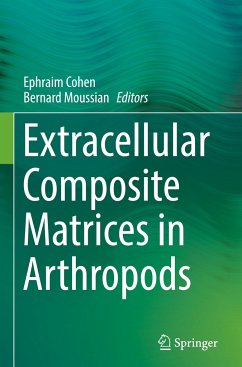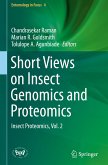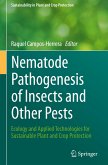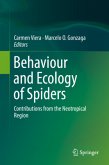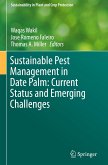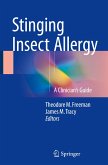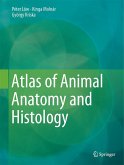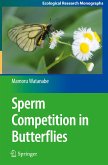Extracellular Composite Matrices in Arthropods
Herausgegeben:Cohen, Ephraim; Moussian, Bernard
Extracellular Composite Matrices in Arthropods
Herausgegeben:Cohen, Ephraim; Moussian, Bernard
- Gebundenes Buch
- Merkliste
- Auf die Merkliste
- Bewerten Bewerten
- Teilen
- Produkt teilen
- Produkterinnerung
- Produkterinnerung
Emphasis is placed on the elaborate cuticular matrices in insects and crustaceans, spider and insect silks, sialomes of phytophagous and blood-feeding arthropods as well as on secretions of male and female accessory glands. Focus is placed largely on insects, due to the extensive body of published research that in part is the result of available whole genome sequences of several model species (in particular Drosophila melanogaster) and accessible ESTs for other species. Such advances have facilitated fundamental insights into genomic, proteomic and molecular biology-based physiology. This new…mehr
Andere Kunden interessierten sich auch für
![Short Views on Insect Genomics and Proteomics Short Views on Insect Genomics and Proteomics]() Short Views on Insect Genomics and Proteomics75,99 €
Short Views on Insect Genomics and Proteomics75,99 €![Nematode Pathogenesis of Insects and Other Pests Nematode Pathogenesis of Insects and Other Pests]() Nematode Pathogenesis of Insects and Other Pests150,99 €
Nematode Pathogenesis of Insects and Other Pests150,99 €![Behaviour and Ecology of Spiders Behaviour and Ecology of Spiders]() Behaviour and Ecology of Spiders134,99 €
Behaviour and Ecology of Spiders134,99 €![Sustainable Pest Management in Date Palm: Current Status and Emerging Challenges Sustainable Pest Management in Date Palm: Current Status and Emerging Challenges]() Sustainable Pest Management in Date Palm: Current Status and Emerging Challenges112,99 €
Sustainable Pest Management in Date Palm: Current Status and Emerging Challenges112,99 €![Stinging Insect Allergy Stinging Insect Allergy]() Stinging Insect Allergy97,99 €
Stinging Insect Allergy97,99 €![Atlas of Animal Anatomy and Histology Atlas of Animal Anatomy and Histology]() Péter LöwAtlas of Animal Anatomy and Histology136,99 €
Péter LöwAtlas of Animal Anatomy and Histology136,99 €![Sperm Competition in Butterflies Sperm Competition in Butterflies]() Mamoru WatanabeSperm Competition in Butterflies112,99 €
Mamoru WatanabeSperm Competition in Butterflies112,99 €-
-
-
Emphasis is placed on the elaborate cuticular matrices in insects and crustaceans, spider and insect silks, sialomes of phytophagous and blood-feeding arthropods as well as on secretions of male and female accessory glands. Focus is placed largely on insects, due to the extensive body of published research that in part is the result of available whole genome sequences of several model species (in particular Drosophila melanogaster) and accessible ESTs for other species. Such advances have facilitated fundamental insights into genomic, proteomic and molecular biology-based physiology. This new volume contains comprehensive contributions on extracellular composite matrices in arthropods. The building blocks of such matrices are formed in and secreted by single layered epithelial cells into exterior domains where their final assembly takes place.Additionally, the unique mechanical properties of natural biocomposites like chitin/chitosan, the crustacean mineralized exoskeleton, the pliant protein resilin or insect and spider silks, have inspired basic and applied research that yield sophistical biomimetics and structural biocomposite hybrids important for future industrial and biomedical use. In summary, this book provides an invaluable vast source of basic and applied information for a plethora of scientists as well as textbook for graduate and advanced undergraduate students.
Produktdetails
- Produktdetails
- Verlag: Springer / Springer International Publishing / Springer, Berlin
- Artikelnr. des Verlages: 978-3-319-40738-8
- 1st edition 2016
- Seitenzahl: 728
- Erscheinungstermin: 22. September 2016
- Englisch
- Abmessung: 241mm x 160mm x 42mm
- Gewicht: 1319g
- ISBN-13: 9783319407388
- ISBN-10: 3319407384
- Artikelnr.: 45005400
- Herstellerkennzeichnung
- Springer-Verlag GmbH
- Tiergartenstr. 17
- 69121 Heidelberg
- ProductSafety@springernature.com
- Verlag: Springer / Springer International Publishing / Springer, Berlin
- Artikelnr. des Verlages: 978-3-319-40738-8
- 1st edition 2016
- Seitenzahl: 728
- Erscheinungstermin: 22. September 2016
- Englisch
- Abmessung: 241mm x 160mm x 42mm
- Gewicht: 1319g
- ISBN-13: 9783319407388
- ISBN-10: 3319407384
- Artikelnr.: 45005400
- Herstellerkennzeichnung
- Springer-Verlag GmbH
- Tiergartenstr. 17
- 69121 Heidelberg
- ProductSafety@springernature.com
Prof. Ephraim Cohen is the Morris and Helen Mauerberger Chair in Agricultural Entomology Academic degrees and appointments: 1972 Lecturer -Tel Aviv University 2000-2003 Head Dept. of Entomology 2001 Chairperson of the Steering Committee for Biological and Chemical Residues in Animals and Animal Products, Ministry of Agriculture, Israel The Hebrew University: 1978 Senior Lecturer 1985 Associate Professor 1990 Professor 1986-1989 Head, Plant Protection Studies 2000 Head, Dept. of Entomology 2004 The Morris Helen Mauerberger Chair in Agricultural Entomology Research Associate at University of California, Berkeley, California (Environmental Chemistry and Toxicology Laboratory) 1977-1979; 1983-1984; 1989; 1994-1995. 1998-1999 University of Melbourne, Melbourne, Australia 2004-2005 University of Sydney, Sydney, Australia.
Part A Skeletal matrices
1 Genes of Cuticular Proteins and their Regulation - H. Kawasaki
1.1 Recent Classification of Cuticular Proteins and the Construction of
Cuticular Layers
1.2 Factors that Affect the Expression of Cuticular Proteins
1.3 Application of Genome Information
1.4 Regulation of Gene Expression of Cuticular Proteins
1.5 Future Prospects
2 Chitin Synthetic and Degradation Pathways - S. Muthukrishnan, Y.
Arakane, H. Merzendorfer and Q. yang
2.1 Introduction
2.2 Structure of Chitin
2.3 Higher Order Structures Involving Chitin Fibers in the Cuticle
2.4 Higher Order Structures in the Peritrophic Matrix
2.5 Precursors of Chitin and generation of Activated Substrates
2.6 Towards the Mode of Action of Insect Chitin Synthases
2.7 Regulation of Chitin Synthesis
2.8 Chitin deacetylation and Possible Role in Cuticle Assembly
2.9 Chitin deacetylases in Insects
2.10 Chitin Degradation
2.11 Chitinolytic N-Acetylglucosaminidase and their Genes
2.12 Additional Proteins Involved in Chitin Protection and Degradation
2.13 Cuticular Proteins Analogous to Peritrophins
2.14 Cuticular Proteins Belonging to R&R and Other Groups
2.15 Concluding Remarks
3 Molecular model of skeletal organization and differentiation - B.
Moussian
3.1 Introduction
3.2 Cuticles of Model Insects
3.3 Conceptual model of cuticle differentiation
3.4 Outlook
4 Resilin - The Pliant Protein - J. Michels, E. Appel, S.N. Gorb
4.1 Introduction
4.2 Biochemistry and molecular biology
4.3 Identification and visualization of resilin
4.4 Mechanical properties of resilin
4.5 Occurrence and function in different systems
4.6 Biomimetics
4.7 Conclusions and outlook
5 The Mineralized Exoskeletons of Crustaceans - S. Bentov, S. Abehsera
and A. Sagi
5.1 Introduction
5.2 The advantage of mineralization
5.3 Degree of mineralization
5.4 Degree of crystallization
5.5 The combination of calcium carbonate and calcium phosphate
5.6 Involvement of proteins and genes
5.7 Potential biomimetic applications inspired by the crustacean
exoskeleton
5.8 Concluding remarks
6 Tyrosine Metabolism in Insect Cuticle Pigmentation and
Sclerotization - M. Y. Noh, T. Asano, J. J. Kramer and Y.
Arakane
6.1 Introduction
6.2 Functions of Key Enzymes/Proteins Involved in Cuticle
Pigmentation and Sclerotization
6.3 Interactions and Functions of Pigments in Insects
6.4 Hormonal Regulation of Cuticle Pigmentation
6.5 Future Prospects and Concluding Remarks
7 Cuticular Hydrocarbons: Biochemistry and Chemical Ecology - M.
D. Ginzel and G. J. Blomquist
7.1 Introduction
7.2 Chemical Composition of Insect Hydrocarbons
7.3 Hydrocarbon Biosynthesis
7.4 Ecological and Behavioral Aspects
7.5 Future Directions
Part B Peritrophic Membranes and Eggshell Matrices -
8 Peritrophic Matrices - H. Merzendorfer, M. Kekenberg and S.
Muthukrishnan
8.1 Introduction
8.2 Structural Components on the Peritrophic Matrix
8.3 Peritrophic Matrix Formation and assembly
8.4 Peritrophic Matrix Properties and Structure-Function
Relationship of Peritrophic
Matrix Components
8.5 Function of the Peritrophic Matrix
8.6 Mechanisms Developed by Pathogens and Parasites to Cross the
Peritrophic
Membrane Barrier
8.7 Comparative Genomics: Peritrophic Matrix Proteins in Different
Insect Orders
8.8 Peritrophic Matrix as a Target for Pest Control
8.9 RNAi-Based Strategies
8.10 Concluding Remarks and Perspectives
9 Composite Eggshell Matrices: Chorionic Layers and Sub-
Chorionic Cuticular Envelopes - G. L. Rezende, H. C. M. Vargas,
B. Moussian and E. Cohen
9.1 Introduction
9.2 Maternal Eggshell Layers
9.3 Cuticular Egg Envelopes of Arthropods
9.4 Concluding Remarks
Part C Skeletal Components as Targets for Interference
10 Targeting Cuticular Components for Pest Management - D. Doucet and
A. Retnakaran
10.1 Introduction
10.2 Structure of the Integument
10.3 The Epicuticle
10.4 The Endocuticle
10.5 Interfering with Chitin Formation and Degradation
10.6 The Exocuticle
10.7 The Eclosion Cascade
10.8 Identifying Other Possible Targets During Cuticle Genesis
10.9 Conclusions
Part D Glandular Secretions -
11 Nature and Functions of Glands and Ducts in the Drosophila
Reproductive Tract
F. W. Avila, J. A. Sánchez-López, J. L. McGlaughon, S. Raman, M. F.
Wolfner and Y. Heifetz
11.1 Introduction
11.2 Setting the Context
11.3 Reproductive Tract Development and Overview
11.4 The Male Reproductive Tract
11.5 Fates of Male Secretions in Mated Females
11.6 The Female Reproductive Tract
11.7 Taking Control - Female Secretions Shape Later Reproductive
Functionality
11.8 Concluding Remarks
12 Molecular and Structural Properties of Spider Silk - T. Crawford,
C. Williams, R. Hekman, S. Dyrness, A. Arata and C. Vierra
12.1 Introduction
12.2 Diversity of Spider Silk
12.3 Natural Silk Extrusion Pathway
12.4 Expression Systems for Recombinant Silk Production
12.5 Biomimicry of the Spinning Process, Applications and Products
12.6 Summary and Future Challenges
13 Spider Silks: Factors Affecting Mechanical Properties and
Biomimetic Applications - S. Zhang and I-M Tso
13.1 Introduction
13.2 Biology of Spider Silk
13.3 Factors Affecting Silk Mechanical Properties
13.4 Current and Potential Applications
13.5 Summary and Future Expectations
14 Insect Silks and Cocoons: Structural and Molecular Aspects -
K. Yukuhiro, H. Sezuku, T. Tsubota, Y. Takasu, T. Kameda and N. Yonemura
14.1 Introduction
14.2 Silk gland morphology
14.3 Cocoons produced by lepidopteran larvae
14.4 Fibroins in lepidopteran silks
14.5 Sericins as glue proteins
14.6 Differences in shape and function of silk glands among insects
14.7 Different features in silks of non-lepidopteran insects
14.8 Gene modification in silk glands using transgenic technology
for industrial use
14.9 Conclusions
15 Glands of Drosophila melanogaster, A Model System - R. Farka
15.1 Introduction
15.2 Larval Exocytotic Activity of Drosophila Salivary Glands
15.3 Apocrine Secretion by Drosophila SGs
Vertebrates
15.4 Conclusions
16 Salivary Gland Secretions of Phytophagous Arthropods - M. P.
Celorio-Mancera and J. M. Labavitch
16.1 Introduction
16. 2 Salivary Glands and their Components
16.3 Salivary Components and the Interaction between Plants and Arthropods
During Herbivory
16.4. Concluding Remarks and Future Perspectives
17 Glandular Matrices and Secretions: Blood-Feeding Arthropods - B. Mans
17. 1 Introduction - Evolution of Blood-Feeding in Arthropods
17.2 The Vector-Host Interphase
17.3 The Host Dermis and Defense Response
17.4 Arthropod Modelling of the Host Matrix
17.5 Arthropod Modulation of Host Defenses
17.6 Sialoverse
17.7 Future Perspectives
1 Genes of Cuticular Proteins and their Regulation - H. Kawasaki
1.1 Recent Classification of Cuticular Proteins and the Construction of
Cuticular Layers
1.2 Factors that Affect the Expression of Cuticular Proteins
1.3 Application of Genome Information
1.4 Regulation of Gene Expression of Cuticular Proteins
1.5 Future Prospects
2 Chitin Synthetic and Degradation Pathways - S. Muthukrishnan, Y.
Arakane, H. Merzendorfer and Q. yang
2.1 Introduction
2.2 Structure of Chitin
2.3 Higher Order Structures Involving Chitin Fibers in the Cuticle
2.4 Higher Order Structures in the Peritrophic Matrix
2.5 Precursors of Chitin and generation of Activated Substrates
2.6 Towards the Mode of Action of Insect Chitin Synthases
2.7 Regulation of Chitin Synthesis
2.8 Chitin deacetylation and Possible Role in Cuticle Assembly
2.9 Chitin deacetylases in Insects
2.10 Chitin Degradation
2.11 Chitinolytic N-Acetylglucosaminidase and their Genes
2.12 Additional Proteins Involved in Chitin Protection and Degradation
2.13 Cuticular Proteins Analogous to Peritrophins
2.14 Cuticular Proteins Belonging to R&R and Other Groups
2.15 Concluding Remarks
3 Molecular model of skeletal organization and differentiation - B.
Moussian
3.1 Introduction
3.2 Cuticles of Model Insects
3.3 Conceptual model of cuticle differentiation
3.4 Outlook
4 Resilin - The Pliant Protein - J. Michels, E. Appel, S.N. Gorb
4.1 Introduction
4.2 Biochemistry and molecular biology
4.3 Identification and visualization of resilin
4.4 Mechanical properties of resilin
4.5 Occurrence and function in different systems
4.6 Biomimetics
4.7 Conclusions and outlook
5 The Mineralized Exoskeletons of Crustaceans - S. Bentov, S. Abehsera
and A. Sagi
5.1 Introduction
5.2 The advantage of mineralization
5.3 Degree of mineralization
5.4 Degree of crystallization
5.5 The combination of calcium carbonate and calcium phosphate
5.6 Involvement of proteins and genes
5.7 Potential biomimetic applications inspired by the crustacean
exoskeleton
5.8 Concluding remarks
6 Tyrosine Metabolism in Insect Cuticle Pigmentation and
Sclerotization - M. Y. Noh, T. Asano, J. J. Kramer and Y.
Arakane
6.1 Introduction
6.2 Functions of Key Enzymes/Proteins Involved in Cuticle
Pigmentation and Sclerotization
6.3 Interactions and Functions of Pigments in Insects
6.4 Hormonal Regulation of Cuticle Pigmentation
6.5 Future Prospects and Concluding Remarks
7 Cuticular Hydrocarbons: Biochemistry and Chemical Ecology - M.
D. Ginzel and G. J. Blomquist
7.1 Introduction
7.2 Chemical Composition of Insect Hydrocarbons
7.3 Hydrocarbon Biosynthesis
7.4 Ecological and Behavioral Aspects
7.5 Future Directions
Part B Peritrophic Membranes and Eggshell Matrices -
8 Peritrophic Matrices - H. Merzendorfer, M. Kekenberg and S.
Muthukrishnan
8.1 Introduction
8.2 Structural Components on the Peritrophic Matrix
8.3 Peritrophic Matrix Formation and assembly
8.4 Peritrophic Matrix Properties and Structure-Function
Relationship of Peritrophic
Matrix Components
8.5 Function of the Peritrophic Matrix
8.6 Mechanisms Developed by Pathogens and Parasites to Cross the
Peritrophic
Membrane Barrier
8.7 Comparative Genomics: Peritrophic Matrix Proteins in Different
Insect Orders
8.8 Peritrophic Matrix as a Target for Pest Control
8.9 RNAi-Based Strategies
8.10 Concluding Remarks and Perspectives
9 Composite Eggshell Matrices: Chorionic Layers and Sub-
Chorionic Cuticular Envelopes - G. L. Rezende, H. C. M. Vargas,
B. Moussian and E. Cohen
9.1 Introduction
9.2 Maternal Eggshell Layers
9.3 Cuticular Egg Envelopes of Arthropods
9.4 Concluding Remarks
Part C Skeletal Components as Targets for Interference
10 Targeting Cuticular Components for Pest Management - D. Doucet and
A. Retnakaran
10.1 Introduction
10.2 Structure of the Integument
10.3 The Epicuticle
10.4 The Endocuticle
10.5 Interfering with Chitin Formation and Degradation
10.6 The Exocuticle
10.7 The Eclosion Cascade
10.8 Identifying Other Possible Targets During Cuticle Genesis
10.9 Conclusions
Part D Glandular Secretions -
11 Nature and Functions of Glands and Ducts in the Drosophila
Reproductive Tract
F. W. Avila, J. A. Sánchez-López, J. L. McGlaughon, S. Raman, M. F.
Wolfner and Y. Heifetz
11.1 Introduction
11.2 Setting the Context
11.3 Reproductive Tract Development and Overview
11.4 The Male Reproductive Tract
11.5 Fates of Male Secretions in Mated Females
11.6 The Female Reproductive Tract
11.7 Taking Control - Female Secretions Shape Later Reproductive
Functionality
11.8 Concluding Remarks
12 Molecular and Structural Properties of Spider Silk - T. Crawford,
C. Williams, R. Hekman, S. Dyrness, A. Arata and C. Vierra
12.1 Introduction
12.2 Diversity of Spider Silk
12.3 Natural Silk Extrusion Pathway
12.4 Expression Systems for Recombinant Silk Production
12.5 Biomimicry of the Spinning Process, Applications and Products
12.6 Summary and Future Challenges
13 Spider Silks: Factors Affecting Mechanical Properties and
Biomimetic Applications - S. Zhang and I-M Tso
13.1 Introduction
13.2 Biology of Spider Silk
13.3 Factors Affecting Silk Mechanical Properties
13.4 Current and Potential Applications
13.5 Summary and Future Expectations
14 Insect Silks and Cocoons: Structural and Molecular Aspects -
K. Yukuhiro, H. Sezuku, T. Tsubota, Y. Takasu, T. Kameda and N. Yonemura
14.1 Introduction
14.2 Silk gland morphology
14.3 Cocoons produced by lepidopteran larvae
14.4 Fibroins in lepidopteran silks
14.5 Sericins as glue proteins
14.6 Differences in shape and function of silk glands among insects
14.7 Different features in silks of non-lepidopteran insects
14.8 Gene modification in silk glands using transgenic technology
for industrial use
14.9 Conclusions
15 Glands of Drosophila melanogaster, A Model System - R. Farka
15.1 Introduction
15.2 Larval Exocytotic Activity of Drosophila Salivary Glands
15.3 Apocrine Secretion by Drosophila SGs
Vertebrates
15.4 Conclusions
16 Salivary Gland Secretions of Phytophagous Arthropods - M. P.
Celorio-Mancera and J. M. Labavitch
16.1 Introduction
16. 2 Salivary Glands and their Components
16.3 Salivary Components and the Interaction between Plants and Arthropods
During Herbivory
16.4. Concluding Remarks and Future Perspectives
17 Glandular Matrices and Secretions: Blood-Feeding Arthropods - B. Mans
17. 1 Introduction - Evolution of Blood-Feeding in Arthropods
17.2 The Vector-Host Interphase
17.3 The Host Dermis and Defense Response
17.4 Arthropod Modelling of the Host Matrix
17.5 Arthropod Modulation of Host Defenses
17.6 Sialoverse
17.7 Future Perspectives
Part A Skeletal matrices
1 Genes of Cuticular Proteins and their Regulation - H. Kawasaki
1.1 Recent Classification of Cuticular Proteins and the Construction of
Cuticular Layers
1.2 Factors that Affect the Expression of Cuticular Proteins
1.3 Application of Genome Information
1.4 Regulation of Gene Expression of Cuticular Proteins
1.5 Future Prospects
2 Chitin Synthetic and Degradation Pathways - S. Muthukrishnan, Y.
Arakane, H. Merzendorfer and Q. yang
2.1 Introduction
2.2 Structure of Chitin
2.3 Higher Order Structures Involving Chitin Fibers in the Cuticle
2.4 Higher Order Structures in the Peritrophic Matrix
2.5 Precursors of Chitin and generation of Activated Substrates
2.6 Towards the Mode of Action of Insect Chitin Synthases
2.7 Regulation of Chitin Synthesis
2.8 Chitin deacetylation and Possible Role in Cuticle Assembly
2.9 Chitin deacetylases in Insects
2.10 Chitin Degradation
2.11 Chitinolytic N-Acetylglucosaminidase and their Genes
2.12 Additional Proteins Involved in Chitin Protection and Degradation
2.13 Cuticular Proteins Analogous to Peritrophins
2.14 Cuticular Proteins Belonging to R&R and Other Groups
2.15 Concluding Remarks
3 Molecular model of skeletal organization and differentiation - B.
Moussian
3.1 Introduction
3.2 Cuticles of Model Insects
3.3 Conceptual model of cuticle differentiation
3.4 Outlook
4 Resilin - The Pliant Protein - J. Michels, E. Appel, S.N. Gorb
4.1 Introduction
4.2 Biochemistry and molecular biology
4.3 Identification and visualization of resilin
4.4 Mechanical properties of resilin
4.5 Occurrence and function in different systems
4.6 Biomimetics
4.7 Conclusions and outlook
5 The Mineralized Exoskeletons of Crustaceans - S. Bentov, S. Abehsera
and A. Sagi
5.1 Introduction
5.2 The advantage of mineralization
5.3 Degree of mineralization
5.4 Degree of crystallization
5.5 The combination of calcium carbonate and calcium phosphate
5.6 Involvement of proteins and genes
5.7 Potential biomimetic applications inspired by the crustacean
exoskeleton
5.8 Concluding remarks
6 Tyrosine Metabolism in Insect Cuticle Pigmentation and
Sclerotization - M. Y. Noh, T. Asano, J. J. Kramer and Y.
Arakane
6.1 Introduction
6.2 Functions of Key Enzymes/Proteins Involved in Cuticle
Pigmentation and Sclerotization
6.3 Interactions and Functions of Pigments in Insects
6.4 Hormonal Regulation of Cuticle Pigmentation
6.5 Future Prospects and Concluding Remarks
7 Cuticular Hydrocarbons: Biochemistry and Chemical Ecology - M.
D. Ginzel and G. J. Blomquist
7.1 Introduction
7.2 Chemical Composition of Insect Hydrocarbons
7.3 Hydrocarbon Biosynthesis
7.4 Ecological and Behavioral Aspects
7.5 Future Directions
Part B Peritrophic Membranes and Eggshell Matrices -
8 Peritrophic Matrices - H. Merzendorfer, M. Kekenberg and S.
Muthukrishnan
8.1 Introduction
8.2 Structural Components on the Peritrophic Matrix
8.3 Peritrophic Matrix Formation and assembly
8.4 Peritrophic Matrix Properties and Structure-Function
Relationship of Peritrophic
Matrix Components
8.5 Function of the Peritrophic Matrix
8.6 Mechanisms Developed by Pathogens and Parasites to Cross the
Peritrophic
Membrane Barrier
8.7 Comparative Genomics: Peritrophic Matrix Proteins in Different
Insect Orders
8.8 Peritrophic Matrix as a Target for Pest Control
8.9 RNAi-Based Strategies
8.10 Concluding Remarks and Perspectives
9 Composite Eggshell Matrices: Chorionic Layers and Sub-
Chorionic Cuticular Envelopes - G. L. Rezende, H. C. M. Vargas,
B. Moussian and E. Cohen
9.1 Introduction
9.2 Maternal Eggshell Layers
9.3 Cuticular Egg Envelopes of Arthropods
9.4 Concluding Remarks
Part C Skeletal Components as Targets for Interference
10 Targeting Cuticular Components for Pest Management - D. Doucet and
A. Retnakaran
10.1 Introduction
10.2 Structure of the Integument
10.3 The Epicuticle
10.4 The Endocuticle
10.5 Interfering with Chitin Formation and Degradation
10.6 The Exocuticle
10.7 The Eclosion Cascade
10.8 Identifying Other Possible Targets During Cuticle Genesis
10.9 Conclusions
Part D Glandular Secretions -
11 Nature and Functions of Glands and Ducts in the Drosophila
Reproductive Tract
F. W. Avila, J. A. Sánchez-López, J. L. McGlaughon, S. Raman, M. F.
Wolfner and Y. Heifetz
11.1 Introduction
11.2 Setting the Context
11.3 Reproductive Tract Development and Overview
11.4 The Male Reproductive Tract
11.5 Fates of Male Secretions in Mated Females
11.6 The Female Reproductive Tract
11.7 Taking Control - Female Secretions Shape Later Reproductive
Functionality
11.8 Concluding Remarks
12 Molecular and Structural Properties of Spider Silk - T. Crawford,
C. Williams, R. Hekman, S. Dyrness, A. Arata and C. Vierra
12.1 Introduction
12.2 Diversity of Spider Silk
12.3 Natural Silk Extrusion Pathway
12.4 Expression Systems for Recombinant Silk Production
12.5 Biomimicry of the Spinning Process, Applications and Products
12.6 Summary and Future Challenges
13 Spider Silks: Factors Affecting Mechanical Properties and
Biomimetic Applications - S. Zhang and I-M Tso
13.1 Introduction
13.2 Biology of Spider Silk
13.3 Factors Affecting Silk Mechanical Properties
13.4 Current and Potential Applications
13.5 Summary and Future Expectations
14 Insect Silks and Cocoons: Structural and Molecular Aspects -
K. Yukuhiro, H. Sezuku, T. Tsubota, Y. Takasu, T. Kameda and N. Yonemura
14.1 Introduction
14.2 Silk gland morphology
14.3 Cocoons produced by lepidopteran larvae
14.4 Fibroins in lepidopteran silks
14.5 Sericins as glue proteins
14.6 Differences in shape and function of silk glands among insects
14.7 Different features in silks of non-lepidopteran insects
14.8 Gene modification in silk glands using transgenic technology
for industrial use
14.9 Conclusions
15 Glands of Drosophila melanogaster, A Model System - R. Farka
15.1 Introduction
15.2 Larval Exocytotic Activity of Drosophila Salivary Glands
15.3 Apocrine Secretion by Drosophila SGs
Vertebrates
15.4 Conclusions
16 Salivary Gland Secretions of Phytophagous Arthropods - M. P.
Celorio-Mancera and J. M. Labavitch
16.1 Introduction
16. 2 Salivary Glands and their Components
16.3 Salivary Components and the Interaction between Plants and Arthropods
During Herbivory
16.4. Concluding Remarks and Future Perspectives
17 Glandular Matrices and Secretions: Blood-Feeding Arthropods - B. Mans
17. 1 Introduction - Evolution of Blood-Feeding in Arthropods
17.2 The Vector-Host Interphase
17.3 The Host Dermis and Defense Response
17.4 Arthropod Modelling of the Host Matrix
17.5 Arthropod Modulation of Host Defenses
17.6 Sialoverse
17.7 Future Perspectives
1 Genes of Cuticular Proteins and their Regulation - H. Kawasaki
1.1 Recent Classification of Cuticular Proteins and the Construction of
Cuticular Layers
1.2 Factors that Affect the Expression of Cuticular Proteins
1.3 Application of Genome Information
1.4 Regulation of Gene Expression of Cuticular Proteins
1.5 Future Prospects
2 Chitin Synthetic and Degradation Pathways - S. Muthukrishnan, Y.
Arakane, H. Merzendorfer and Q. yang
2.1 Introduction
2.2 Structure of Chitin
2.3 Higher Order Structures Involving Chitin Fibers in the Cuticle
2.4 Higher Order Structures in the Peritrophic Matrix
2.5 Precursors of Chitin and generation of Activated Substrates
2.6 Towards the Mode of Action of Insect Chitin Synthases
2.7 Regulation of Chitin Synthesis
2.8 Chitin deacetylation and Possible Role in Cuticle Assembly
2.9 Chitin deacetylases in Insects
2.10 Chitin Degradation
2.11 Chitinolytic N-Acetylglucosaminidase and their Genes
2.12 Additional Proteins Involved in Chitin Protection and Degradation
2.13 Cuticular Proteins Analogous to Peritrophins
2.14 Cuticular Proteins Belonging to R&R and Other Groups
2.15 Concluding Remarks
3 Molecular model of skeletal organization and differentiation - B.
Moussian
3.1 Introduction
3.2 Cuticles of Model Insects
3.3 Conceptual model of cuticle differentiation
3.4 Outlook
4 Resilin - The Pliant Protein - J. Michels, E. Appel, S.N. Gorb
4.1 Introduction
4.2 Biochemistry and molecular biology
4.3 Identification and visualization of resilin
4.4 Mechanical properties of resilin
4.5 Occurrence and function in different systems
4.6 Biomimetics
4.7 Conclusions and outlook
5 The Mineralized Exoskeletons of Crustaceans - S. Bentov, S. Abehsera
and A. Sagi
5.1 Introduction
5.2 The advantage of mineralization
5.3 Degree of mineralization
5.4 Degree of crystallization
5.5 The combination of calcium carbonate and calcium phosphate
5.6 Involvement of proteins and genes
5.7 Potential biomimetic applications inspired by the crustacean
exoskeleton
5.8 Concluding remarks
6 Tyrosine Metabolism in Insect Cuticle Pigmentation and
Sclerotization - M. Y. Noh, T. Asano, J. J. Kramer and Y.
Arakane
6.1 Introduction
6.2 Functions of Key Enzymes/Proteins Involved in Cuticle
Pigmentation and Sclerotization
6.3 Interactions and Functions of Pigments in Insects
6.4 Hormonal Regulation of Cuticle Pigmentation
6.5 Future Prospects and Concluding Remarks
7 Cuticular Hydrocarbons: Biochemistry and Chemical Ecology - M.
D. Ginzel and G. J. Blomquist
7.1 Introduction
7.2 Chemical Composition of Insect Hydrocarbons
7.3 Hydrocarbon Biosynthesis
7.4 Ecological and Behavioral Aspects
7.5 Future Directions
Part B Peritrophic Membranes and Eggshell Matrices -
8 Peritrophic Matrices - H. Merzendorfer, M. Kekenberg and S.
Muthukrishnan
8.1 Introduction
8.2 Structural Components on the Peritrophic Matrix
8.3 Peritrophic Matrix Formation and assembly
8.4 Peritrophic Matrix Properties and Structure-Function
Relationship of Peritrophic
Matrix Components
8.5 Function of the Peritrophic Matrix
8.6 Mechanisms Developed by Pathogens and Parasites to Cross the
Peritrophic
Membrane Barrier
8.7 Comparative Genomics: Peritrophic Matrix Proteins in Different
Insect Orders
8.8 Peritrophic Matrix as a Target for Pest Control
8.9 RNAi-Based Strategies
8.10 Concluding Remarks and Perspectives
9 Composite Eggshell Matrices: Chorionic Layers and Sub-
Chorionic Cuticular Envelopes - G. L. Rezende, H. C. M. Vargas,
B. Moussian and E. Cohen
9.1 Introduction
9.2 Maternal Eggshell Layers
9.3 Cuticular Egg Envelopes of Arthropods
9.4 Concluding Remarks
Part C Skeletal Components as Targets for Interference
10 Targeting Cuticular Components for Pest Management - D. Doucet and
A. Retnakaran
10.1 Introduction
10.2 Structure of the Integument
10.3 The Epicuticle
10.4 The Endocuticle
10.5 Interfering with Chitin Formation and Degradation
10.6 The Exocuticle
10.7 The Eclosion Cascade
10.8 Identifying Other Possible Targets During Cuticle Genesis
10.9 Conclusions
Part D Glandular Secretions -
11 Nature and Functions of Glands and Ducts in the Drosophila
Reproductive Tract
F. W. Avila, J. A. Sánchez-López, J. L. McGlaughon, S. Raman, M. F.
Wolfner and Y. Heifetz
11.1 Introduction
11.2 Setting the Context
11.3 Reproductive Tract Development and Overview
11.4 The Male Reproductive Tract
11.5 Fates of Male Secretions in Mated Females
11.6 The Female Reproductive Tract
11.7 Taking Control - Female Secretions Shape Later Reproductive
Functionality
11.8 Concluding Remarks
12 Molecular and Structural Properties of Spider Silk - T. Crawford,
C. Williams, R. Hekman, S. Dyrness, A. Arata and C. Vierra
12.1 Introduction
12.2 Diversity of Spider Silk
12.3 Natural Silk Extrusion Pathway
12.4 Expression Systems for Recombinant Silk Production
12.5 Biomimicry of the Spinning Process, Applications and Products
12.6 Summary and Future Challenges
13 Spider Silks: Factors Affecting Mechanical Properties and
Biomimetic Applications - S. Zhang and I-M Tso
13.1 Introduction
13.2 Biology of Spider Silk
13.3 Factors Affecting Silk Mechanical Properties
13.4 Current and Potential Applications
13.5 Summary and Future Expectations
14 Insect Silks and Cocoons: Structural and Molecular Aspects -
K. Yukuhiro, H. Sezuku, T. Tsubota, Y. Takasu, T. Kameda and N. Yonemura
14.1 Introduction
14.2 Silk gland morphology
14.3 Cocoons produced by lepidopteran larvae
14.4 Fibroins in lepidopteran silks
14.5 Sericins as glue proteins
14.6 Differences in shape and function of silk glands among insects
14.7 Different features in silks of non-lepidopteran insects
14.8 Gene modification in silk glands using transgenic technology
for industrial use
14.9 Conclusions
15 Glands of Drosophila melanogaster, A Model System - R. Farka
15.1 Introduction
15.2 Larval Exocytotic Activity of Drosophila Salivary Glands
15.3 Apocrine Secretion by Drosophila SGs
Vertebrates
15.4 Conclusions
16 Salivary Gland Secretions of Phytophagous Arthropods - M. P.
Celorio-Mancera and J. M. Labavitch
16.1 Introduction
16. 2 Salivary Glands and their Components
16.3 Salivary Components and the Interaction between Plants and Arthropods
During Herbivory
16.4. Concluding Remarks and Future Perspectives
17 Glandular Matrices and Secretions: Blood-Feeding Arthropods - B. Mans
17. 1 Introduction - Evolution of Blood-Feeding in Arthropods
17.2 The Vector-Host Interphase
17.3 The Host Dermis and Defense Response
17.4 Arthropod Modelling of the Host Matrix
17.5 Arthropod Modulation of Host Defenses
17.6 Sialoverse
17.7 Future Perspectives

